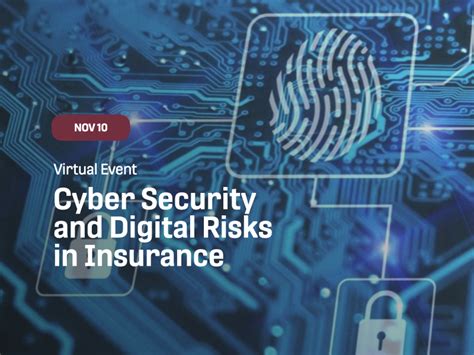Cyber Risk Insurance

In today's digital landscape, businesses and individuals are increasingly exposed to a wide range of cyber threats and risks. From data breaches and ransomware attacks to business interruption and privacy violations, the potential consequences of cyber incidents can be devastating. As a result, cyber risk insurance has emerged as a crucial tool for mitigating financial losses and ensuring business continuity in the face of ever-evolving cyber threats.
Understanding Cyber Risk Insurance

Cyber risk insurance, also known as cyber liability insurance or cyber insurance, is a specialized form of insurance designed to protect businesses and individuals from the financial fallout of cyber attacks and data breaches. It provides coverage for various cyber-related risks, including but not limited to:
- Data breach and privacy liability: Coverage for legal costs, regulatory fines, and customer notification expenses in the event of a data breach or privacy violation.
- Network security and media liability: Protection against claims arising from network security failures, such as hacking or malware attacks, as well as defamation or copyright infringement suits.
- Business interruption and extra expenses: Compensation for lost income and additional expenses incurred due to a cyber incident that disrupts normal business operations.
- Cyber extortion: Assistance in negotiating and covering ransom demands made by cybercriminals, including ransomware attacks.
- Cyber crime and funds transfer fraud: Coverage for financial losses resulting from fraudulent wire transfers, phishing attacks, and other cyber-enabled crimes.
- Privacy and security breach response services: Access to expert resources to help mitigate the impact of a data breach, including forensics, legal advice, and public relations support.
Cyber risk insurance policies are typically tailored to the specific needs and risks of the insured, taking into account factors such as industry, size of the organization, and the nature of sensitive data handled. Policies can be customized to include additional coverages, such as cyber terrorism, cyber theft, and social engineering fraud.
Key Considerations in Cyber Risk Insurance
When evaluating cyber risk insurance options, it is essential to consider the following factors to ensure adequate protection:
- Limit of Liability: The maximum amount the insurer will pay for covered losses. Higher limits are often necessary to cover the potential costs of a major data breach or cyber attack.
- Deductibles and Retention: The portion of the loss that the insured must pay before the insurer's coverage kicks in. Higher deductibles can lower premiums but increase the financial burden on the insured in the event of a claim.
- Policy Exclusions: Understanding what is not covered by the policy is critical. Common exclusions include war, terrorism, and intentional acts.
- Coverage Triggers: The specific events or circumstances that must occur for coverage to be activated. Policies may have different triggers, such as a confirmed data breach or a ransomware attack.
- Sub-Limits: Maximum amounts that can be paid for specific types of losses within the overall policy limit. Sub-limits can be particularly important for costly incidents like data breach response expenses.
Benefits and Real-World Impact of Cyber Risk Insurance

Cyber risk insurance offers a range of benefits that can significantly impact businesses and individuals facing cyber threats:
Financial Protection and Peace of Mind
Cyber risk insurance provides financial protection against the potentially catastrophic costs of cyber incidents. A single data breach or ransomware attack can result in millions of dollars in legal fees, regulatory fines, and customer notification expenses. With cyber insurance, businesses can mitigate these financial risks and maintain financial stability.
Assistance in Incident Response
Many cyber risk insurance policies include access to specialized response services. In the event of a breach, insured parties can leverage these services to quickly and effectively manage the incident. This can include assistance with data forensics, legal compliance, and public relations management, ensuring a swift and professional response.
Reputation Management
Data breaches and cyber attacks can severely damage an organization’s reputation. Cyber risk insurance can help mitigate this impact by providing resources to manage public relations and maintain trust with customers and stakeholders. Prompt and transparent communication, enabled by insurance-provided support, can minimize the long-term reputational harm.
Compliance and Regulatory Support
As data privacy regulations, such as GDPR and CCPA, become increasingly stringent, businesses face growing legal obligations to protect customer data. Cyber risk insurance can help organizations navigate these complex regulatory landscapes by providing coverage for legal fees and fines associated with non-compliance. It can also assist with meeting the reporting and notification requirements mandated by such regulations.
Business Continuity
A cyber incident can disrupt normal business operations, leading to significant financial losses. Cyber risk insurance provides coverage for business interruption, helping organizations recover lost income and cover extra expenses incurred during the recovery process. This ensures businesses can maintain financial stability and continue operating even in the face of a major cyber event.
Real-World Examples of Cyber Risk Insurance in Action
The following case studies illustrate the critical role cyber risk insurance can play in mitigating the financial and operational impacts of cyber incidents:
Data Breach at a Healthcare Provider
A large healthcare provider suffered a data breach affecting over 1 million patient records. The breach resulted in significant legal costs, regulatory fines, and customer notification expenses. With comprehensive cyber risk insurance coverage, the provider was able to manage these costs effectively and focus on enhancing its security measures to prevent future incidents.
Ransomware Attack on a Manufacturing Firm
A manufacturing firm fell victim to a ransomware attack that encrypted critical files and disrupted operations. The firm’s cyber risk insurance policy covered the cost of negotiating with the cybercriminals and paying the ransom demand. Additionally, the policy provided business interruption coverage, helping the firm recover lost income and cover extra expenses during the recovery process.
Phishing Attack on a Financial Institution
A financial institution was targeted by a sophisticated phishing attack that resulted in the fraudulent transfer of funds. The institution’s cyber risk insurance policy included coverage for funds transfer fraud, enabling them to recover the lost funds and cover the costs of investigating and mitigating the attack. The policy also provided access to expert resources to enhance the institution’s security measures and prevent similar incidents in the future.
The Future of Cyber Risk Insurance
As cyber threats continue to evolve and become more sophisticated, the demand for cyber risk insurance is expected to grow. Insurers are increasingly developing innovative solutions to meet the changing needs of businesses and individuals in the digital age. Some key trends and considerations for the future of cyber risk insurance include:
Emerging Risks and Coverage
Insurers are expanding their policies to cover emerging cyber risks, such as ransomware-as-a-service, supply chain attacks, and IoT device vulnerabilities. As new threats emerge, insurers will need to stay ahead of the curve to provide adequate coverage.
Risk Assessment and Pricing
Insurers are increasingly utilizing advanced analytics and data-driven approaches to assess cyber risks and price policies. This includes the use of machine learning and predictive modeling to better understand an organization’s risk profile and tailor coverage accordingly.
Collaborative Approaches
Insurers, cybersecurity firms, and other stakeholders are forming collaborative partnerships to better understand and mitigate cyber risks. These collaborations aim to share knowledge, resources, and best practices to enhance the overall cybersecurity ecosystem and improve risk management.
Policyholder Education and Support
Insurers are recognizing the importance of policyholder education and support in reducing cyber risks. Many insurers are now offering risk management tools, training resources, and expert guidance to help policyholders improve their cybersecurity posture and prevent incidents.
Table: Sample Cyber Risk Insurance Policy Coverage
| Coverage Category | Coverage Details |
|---|---|
| Data Breach and Privacy Liability | Legal defense costs, regulatory fines, customer notification expenses, and credit monitoring services. |
| Network Security and Media Liability | Coverage for hacking, malware, and other network security failures, as well as defamation and copyright infringement suits. |
| Business Interruption and Extra Expenses | Compensation for lost income and additional expenses incurred due to a cyber incident, including downtime, data restoration, and alternative workplace expenses. |
| Cyber Extortion | Negotiation support and coverage for ransom payments in the event of a ransomware attack or other cyber extortion incident. |
| Cyber Crime and Funds Transfer Fraud | Protection against financial losses resulting from fraudulent wire transfers, phishing attacks, and other cyber-enabled crimes. |
| Privacy and Security Breach Response Services | Access to expert resources for incident response, including data forensics, legal advice, and public relations support. |

Frequently Asked Questions
What is the difference between cyber risk insurance and traditional liability insurance?
+Cyber risk insurance is a specialized form of insurance that covers losses specifically related to cyber incidents, such as data breaches, hacking, and ransomware attacks. Traditional liability insurance, on the other hand, typically provides coverage for general liability risks, including bodily injury, property damage, and personal injury claims. While some traditional policies may offer limited cyber coverage as an endorsement or rider, cyber risk insurance policies are designed to provide comprehensive protection against the unique risks associated with cyber threats.
How can I determine the right level of cyber risk insurance coverage for my business?
+Determining the appropriate level of cyber risk insurance coverage involves assessing your business’s unique risks and potential exposure. Factors to consider include the type and sensitivity of data you handle, the size and complexity of your IT infrastructure, and your industry’s regulatory requirements. It’s crucial to work with an experienced insurance broker or cybersecurity consultant who can help you evaluate your risks and tailor a policy to your specific needs. Regular policy reviews are also essential to ensure your coverage remains adequate as your business evolves and cyber threats evolve.
What steps can I take to reduce my cyber risk insurance premiums?
+Reducing cyber risk insurance premiums often involves implementing robust cybersecurity measures to demonstrate your commitment to risk mitigation. Insurers may offer premium discounts for businesses that meet certain security standards or have robust incident response plans in place. Regular security audits, employee training on cybersecurity best practices, and the use of advanced security technologies can all contribute to lowering your cyber risk insurance premiums. Additionally, bundling your cyber insurance with other types of coverage, such as property or liability insurance, may result in cost savings.
What happens if my cyber risk insurance claim is denied?
+If your cyber risk insurance claim is denied, it’s important to understand the reasons for the denial and explore your options for appeal. Denials can occur for various reasons, such as policy exclusions, late reporting, or failure to meet the policy’s conditions. Review the denial letter carefully and consider seeking legal advice to determine if there are grounds for challenging the decision. It’s also advisable to work closely with your insurance broker or agent to understand the denial and explore alternative coverage options.
How can I prepare for a potential cyber incident to maximize my insurance coverage?
+Preparing for a potential cyber incident is crucial to ensuring your cyber risk insurance coverage provides the protection you need. Key steps include conducting regular risk assessments to identify vulnerabilities and implementing robust cybersecurity measures to mitigate those risks. Develop and regularly test an incident response plan to ensure your organization knows how to respond effectively in the event of a cyber attack. Additionally, maintain detailed records of your cybersecurity measures and incident response activities to provide clear evidence of your efforts when filing an insurance claim.



